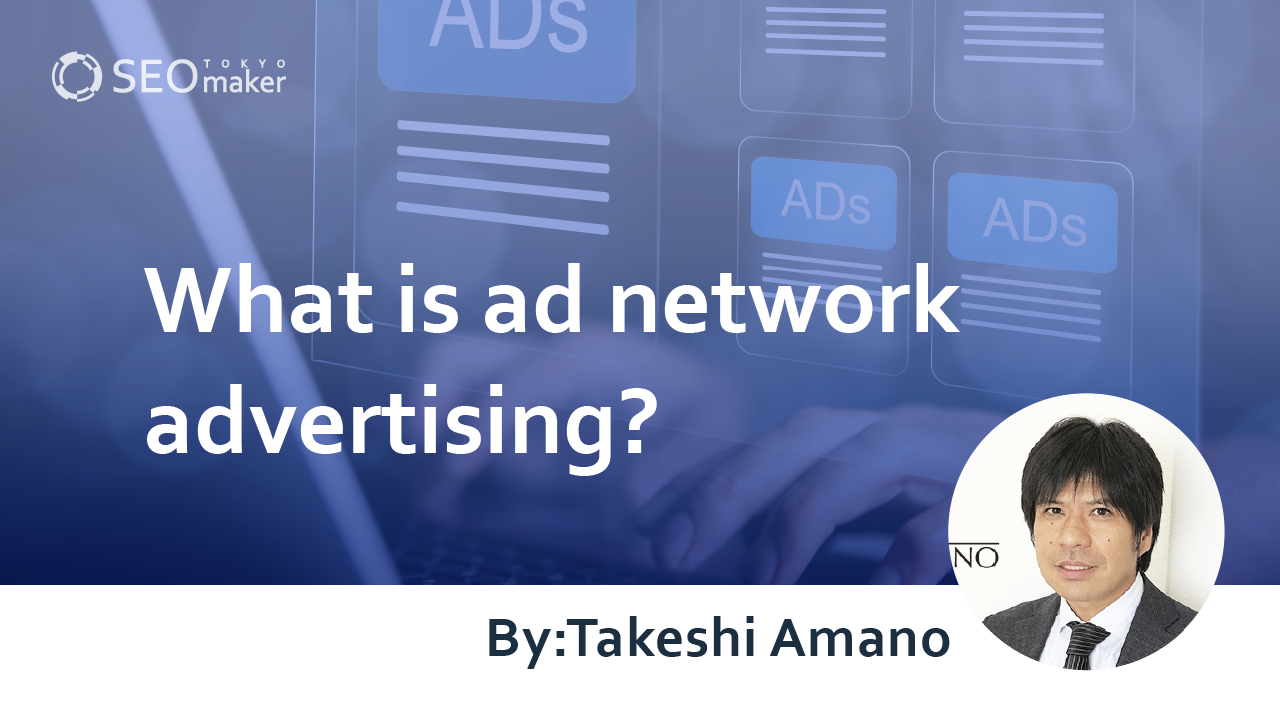What is ad network advertising?
contents
- 1 Introduction to Ad Network Advertising
- 2 Benefits of Ad Networks
- 3 Disadvantages of Ad Networks
- 4 Prominent ad network services
- 5 Other Ad Network Services
- 6 Managing Ad Network Advertising
- 7 Choosing the Right Ad Network
- 8 Enhancing the Effectiveness of Ad Network Advertising
- 9 Making the Most of Ad Network Advertising
- 10 Summary

In the realm of web-based customer acquisition, there are primarily two methods. The first targets potential customers who are already aware they need a product, utilizing strategies such as SEO or paid search ads. The second method, which we’ll discuss today, targets latent customers who are not yet aware of their desire for the products.
By using ad network advertising, businesses can reach prospective customers who were previously unreachable, introducing them to their products.
Let me explain the basic principles of ad network advertising, including its advantages and disadvantages.
Introduction to Ad Network Advertising
Firstly, I’ll clarify the fundamental concepts of ad network advertising.
What is an ad network?
An ad network is a collective of businesses and individuals who run websites and are looking to place ads on their media. For example, owners of a news site might naturally consider monetizing their site by hosting advertisements. This rationale also applies to owners of various types of the following sites.
- Product comparison sites
- Corporate sites
- Personal blogs
- Compilation sites
- Affiliate sites
Additionally, this extends to owners who develop apps and want to display ads within them. These are the types of media that an ad network gathers to meet the advertising needs.
Using Ad Networks to Deploy Ads
Many web managers are interested in distributing ads through ad networks, which are conglomerates of various media.
Ad network advertising connects media owners with web managers who want to place ads. Web managers can utilize these ad networks to distribute their advertisements efficiently.
Previously Dominant Direct Ads
Traditionally, to place ads on a specific website, web managers used a method called direct advertising.
For instance, if a web manager wanted to advertise on a particular site, they would directly contact the media owner, discuss terms like ad duration and cost, and if both parties agreed, they would sign a contract.
This process had to be repeated every time a web manager wanted to place an ad on a new site.
Challenges Addressed by Ad Networks
Direct advertising was highly effective if the media and ads were well-matched. However, it faced several challenges.
- Media could not earn revenue while waiting for advertisers.
- Web managers found it difficult to locate suitable media for their ads.
- Managing ads across multiple media outlets was challenging.
- Advertisers had to continue ads during the contract period, even if the results were not cost-effective.
Ad network advertising has resolved these issues all at once.
For web managers, there’s no longer a need to search for advertising venues. For media owners, it has become possible to continuously host ads, preventing potential losses during periods without advertisers.
Benefits of Ad Networks
For web managers using ad network advertising, the benefits include the following.
- Ability to advertise across multiple media.
- Significantly reduced time from ad conception to deployment.
- Centralized performance tracking.
- Easier optimization of ad effectiveness.
Let’s discuss each of these advantages in detail.
Advertising Across Multiple Media
With direct advertising, finding even a single website willing to host your ads can be a significant effort.
In contrast, ad network advertising offers a ready-made collection of media that can host ads, greatly reducing the workload for web managers. Moreover, ad network platforms continuously expand their available media, doing this work on behalf of the companies.
Significantly Shortened Ad Deployment Process
With direct ads, you must find media willing to host your ads and negotiate contracts individually, often aborting the process if terms are not met.
However, using ad network advertising eliminates such negotiations, enabling ad deployment in as little as one to two days.
Centralized Performance Measurement
Typically, when advertising across multiple media, you need to measure the effectiveness of each media individually. Managing different billing methods and data metrics for each media can be cumbersome.
Ad networks standardize these aspects, making data measurement straightforward.
Easier Optimization of Advertising Effectiveness
With direct advertising, you are committed to the duration of the contract, even if the ads are ineffective.
Ad network advertising allows you to withhold ads from ineffective media and allocate your budget to those that work, making it easier to optimize your advertising effectiveness. This flexibility in choosing where to advertise simplifies improving ad performance.
Disadvantages of Ad Networks
The drawbacks of ad network advertising are as follows.
- You can’t always guarantee placement in specific media.
- Ads might appear in unintended media.
- The cost per ad is trending upward.
Let’s explain each of these points in detail.
Not Guaranteed Placement in Specific Media
Suppose you find a particular media that is highly effective for your ads. You might want to ensure your ads always appear there, but realistically, this can be challenging.
This is because placement is determined through competition with other companies. If you lose in an auction to other companies who also want to place ads in the same media, their ads will be shown instead.
Ads Might Appear in Unintended Media
While ad network advertising allows you to choose preferred categories, you won’t know exactly where your ads will end up until they are deployed.
As a result, your ads might appear in media that could harm your brand’s image.
Rising Cost Per Ad
As ad network advertising proves effective, more competitors will enter the market. This increased competition inevitably leads to higher advertising costs, meaning that over time, the cost per ad tends to increase.
Prominent ad network services
For those interested in utilizing ad network advertising, here are two prominent ad network services to consider.
Google Ads
Quote: GDN
The Google Display Network (GDN) is the largest ad network in the world, part of Google Ads. It allows you to display ads on over 35 million websites, including YouTube and Gmail. With optional targeting settings, ads are automatically filtered and delivered based on factors like timing and placement.
You can also set your advertising budget and target conversion cost per transaction, enabling you to maximize the effectiveness of your ads.
Yahoo! Ads
Quote: yahoo Ads
Yahoo! Ads allows you to use display advertising, targeting options like Yahoo! News, Tabelog, and Line. Ads are automatically selected based on the target demographic’s gender and interests. Like Google Ads, you can set your advertising budget and the amount you’re willing to spend per conversion.
Other Ad Network Services
Rakuten Ad Network
Quote: Rakuten Ad Network
The Rakuten Ad Network offers extensive reach across Rakuten Group’s websites and uses purchasing data from Rakuten Ichiba to target ads. It’s a performance-based advertising system capable of delivering ads at all stages of consumer behavior, from awareness to purchase and loyalty.
MicroAd
Quote: Microad
MicroAd offers targeting by gender, age, and more, and allows for broad media distribution without specific targeting, which can lower ad costs. It is a domestic DSP (Demand Side Platform) that enables diverse targeting strategies.
LINE Ad Network
Quote: LINE Ad Network
The LINE Ad Network offers a unique publisher-oriented solution for monetizing with a wide range of advertising campaigns available only through LINE ads. The service is designed to enhance the user experience and maximize ad revenue, supporting the growth of its partners.
Managing Ad Network Advertising
Ad network advertising offers several delivery methods and pricing models for each medium. Here, we outline the main ones.
Ad Network Advertising Delivery Methods
There are primarily two types of delivery methods in ad network advertising.
Targeted Delivery
Ads are delivered only to media and users who meet predefined criteria such as age, gender, and interests. By deploying targeted advertising, you can reduce unnecessary ad spend and achieve more effective operations. This method is often chosen for campaigns aiming for conversions.
Broad Reach Delivery
This method involves delivering ads across all media without setting specific targets. It is characterized by lower ad costs and is effective for increasing brand awareness, rather than for conversion-focused objectives.
Ad Network Advertising Pricing Models
The main billing methods available in ad network advertising are the following 2 methods.
Cost Per Click (CPC)
CPC is a common choice when using ad network advertising. Here, you are charged based on the number of clicks your ad receives. For example, if the cost is $0.10 per click, 100 clicks would cost $10.
When setting this up, you would typically decide on a monthly advertising budget and estimate the number of clicks. For instance, with a budget of $1,000 and a cost of $0.10 per click, you could receive up to 10,000 clicks.
Cost Per Impression (CPM)
In CPM billing, you are charged each time an ad is displayed in a user’s browser. The cost is based on the number of views your ad receives. This option tends to be cheaper and is used primarily to increase brand awareness rather than for direct conversions.
Choosing the Right Ad Network
How should you decide which ad network to use? The effectiveness of ad network advertising significantly depends on how well your product category matches with the media. Start by checking which websites the ad network displays ads on.
If you believe that your potential customers regularly visit these websites, then choosing that ad network is appropriate. If you’re unsure about the websites your customers frequently visit, consider surveying them to gain insights.
While it might seem cumbersome, understanding your customers makes it easier to choose the right ad network.
Enhancing the Effectiveness of Ad Network Advertising
To boost the effectiveness of your ad network campaigns, you need to run ads, measure the results, and make necessary improvements.
Sometimes, unexpected media sources can bring in quality prospects, while others may not perform as well as anticipated.
No one can predict this without actually running the ads, so it’s essential to iterate through testing and improving based on the results.
Making the Most of Ad Network Advertising
One of the greatest advantages of ad network advertising is its ability to reach potential customers. By connecting with customers who are not yet aware of your products, you have the potential to significantly increase sales.
Moreover, compared to options like search engine marketing, ad network ads generally cost less, making them an effective tool for increasing brand awareness. If your goal is to introduce your products to a broader audience, consider leveraging ad network advertising.
Summary
I’ve explained the basics and effective practices of ad network advertising. Managing such campaigns is not difficult—it involves selecting target demographics like age and gender of prospective customers. As I’ve mentioned, continuous performance measurement will gradually refine this method into an effective marketing strategy. Remember these points if you plan to use ad network advertising in your company.










![What is a Description? Explaining the Meaning, Writing Style, and Changing Word Count – [2023 Edition]](https://www.switchitmaker2.com/en/wp-content/uploads/2024/09/what-is-description.webp)










